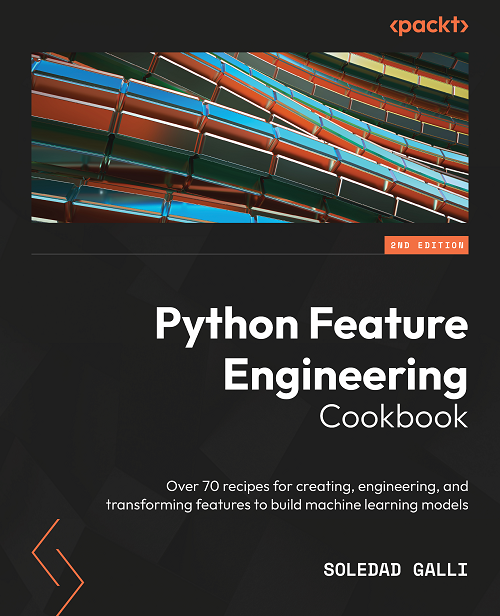Pipeline#
Pipeline facilitates the chaining together of multiple estimators into a unified sequence. This proves beneficial
as data processing frequently involves a predefined series of actions, such as feature selection, normalization, and
training a machine learning model.
Feature-engine’s Pipeline is different from scikit-learn’s Pipeline in that our Pipeline supports
transformers that remove rows from the dataset, like DropMissingData, OutlierTrimmer, LagFeatures and WindowFeatures.
When observations are removed from the training data set, Pipeline invokes the method transform_x_y
available in these transformers, to adjust the target variable to the remaining rows.
The Pipeline serves various functions in this context:
Simplicity and encapsulation:
You need only call the fit and predict functions once on your data to fit an entire sequence of estimators.
Hyperparameter Optimization:
Grid search and random search can be performed over hyperparameters of all estimators in the pipeline simultaneously.
Safety
Using a pipeline prevent the leakage of statistics from test data into the trained model during cross-validation, by ensuring that the same data is used to fit the transformers and predictors.
Pipeline functions#
Calling the fit function on the pipeline, is the same as calling fit on each individual estimator sequentially,
transforming the input data and forwarding it to the subsequent step.
The pipeline will have all the methods present in the final estimator within it. For instance, if the last estimator is a classifier, the Pipeline can function as a classifier. Similarly, if the last estimator is a transformer, the pipeline inherits this functionality as well.
Setting up a Pipeline#
The Pipeline is constructed utilizing a list of (key, value) pairs, wherein the key represents the desired
name for the step, and the value denotes an estimator or a transformer object.
In the following example, we set up a Pipeline that drops missing data, then replaces categories with ordinal
numbers, and finally fits a Lasso regression model.
import numpy as np
import pandas as pd
from feature_engine.imputation import DropMissingData
from feature_engine.encoding import OrdinalEncoder
from feature_engine.pipeline import Pipeline
from sklearn.linear_model import Lasso
X = pd.DataFrame(
dict(
x1=[2, 1, 1, 0, np.nan],
x2=["a", np.nan, "b", np.nan, "a"],
)
)
y = pd.Series([1, 2, 3, 4, 5])
pipe = Pipeline(
[
("drop", DropMissingData()),
("enc", OrdinalEncoder(encoding_method="arbitrary")),
("lasso", Lasso(random_state=10)),
]
)
# predict
pipe.fit(X, y)
preds_pipe = pipe.predict(X)
preds_pipe
In the output we see the predictions made by the pipeline:
array([2., 2.])
Accessing Pipeline steps#
The Pipeline’s estimators are stored as a list within the steps attribute. We can use slicing notation to
obtain a subset or partial pipeline within the Pipeline. This functionality is useful for executing specific
transformations or their inverses selectively.
For example, this notation extracts the first step of the pipeline:
pipe[:1]
Pipeline(steps=[('drop', DropMissingData())])
This notation extracts the first two steps of the pipeline:
pipe[:2]
Pipeline(steps=[('drop', DropMissingData()),
('enc', OrdinalEncoder(encoding_method='arbitrary'))])
This notation extracts the last step of the pipeline:
pipe[-1:]
Pipeline(steps=[('lasso', Lasso(random_state=10))])
We can also select specific steps of the pipeline to check their attributes. For example, we can check the coefficients of the Lasso algorithm as follows:
pipe.named_steps["lasso"].coef_
And we see the coefficients:
array([-0., 0.])
There was no relationship between the target and the variables, so it’s fine to obtain these coefficients.
Let’s instead check the ordinal encoder mappings for the categorical variables:
pipe.named_steps["enc"].encoder_dict_
We see the integers used to replace each category:
{'x2': {'a': 0, 'b': 1}}
Finding feature names in a Pipeline#
The Pipeline includes a get_feature_names_out() method, similar to other transformers. By employing
pipeline slicing, you can obtain the feature names entering each step.
Let’s set up a Pipeline that adds new features to the dataset to make this more interesting:
import numpy as np
import pandas as pd
from feature_engine.imputation import DropMissingData
from feature_engine.encoding import OneHotEncoder
from feature_engine.pipeline import Pipeline
from sklearn.linear_model import Lasso
X = pd.DataFrame(
dict(
x1=[2, 1, 1, 0, np.nan],
x2=["a", np.nan, "b", np.nan, "a"],
)
)
y = pd.Series([1, 2, 3, 4, 5])
pipe = Pipeline(
[
("drop", DropMissingData()),
("enc", OneHotEncoder()),
("lasso", Lasso(random_state=10)),
]
)
pipe.fit(X, y)
In the first step of the pipeline, no features are added, we just drop rows with nan. So if we execute
get_feature_names_out() we should see just the 2 variables from the input dataframe:
pipe[:1].get_feature_names_out()
['x1', 'x2']
In the second step, we add binary variables for each category of x2, so x2 should disappear, and in its place, we should see the binary variables:
pipe[:2].get_feature_names_out()
['x1', 'x2_a', 'x2_b']
The last step is an estimator, that is, a machine learning model. Estimators don’t support the method
get_feature_names_out(). So if we apply this method to the entire pipeline, we’ll get an error.
Accessing nested parameters#
We can re-define, or re-set the parameters of the transformers and estimators within the pipeline. This is done under
the hood by the Grid search and random search. But in case you need to change a parameter in a step of the
Pipeline, this is how you do it:
pipe.set_params(lasso__alpha=10)
Here, we changed the alpha of the lasso regression algorithm to 10.
Best use: Dropping rows during data preprocessing#
Feature-engine’s Pipeline was designed to support transformers that remove rows from the dataset, like
DropMissingData, OutlierTrimmer, LagFeatures and WindowFeatures.
We saw earlier in this page how to use Pipeline with DropMissingData. Let’s now take a look at how to
combine Pipeline with LagFeatures and WindowFeaures to do multiple step forecasting.
We start by making imports:
import numpy as np
import matplotlib.pyplot as plt
import pandas as pd
from sklearn.linear_model import Lasso
from sklearn.metrics import root_mean_squared_error
from sklearn.multioutput import MultiOutputRegressor
from feature_engine.timeseries.forecasting import (
LagFeatures,
WindowFeatures,
)
from feature_engine.pipeline import Pipeline
We’ll use the Australia electricity demand dataset described here:
Godahewa, Rakshitha, Bergmeir, Christoph, Webb, Geoff, Hyndman, Rob, & Montero-Manso, Pablo. (2021). Australian Electricity Demand Dataset (Version 1) [Data set]. Zenodo. https://doi.org/10.5281/zenodo.4659727
url = "https://raw.githubusercontent.com/tidyverts/tsibbledata/master/data-raw/vic_elec/VIC2015/demand.csv"
df = pd.read_csv(url)
df.drop(columns=["Industrial"], inplace=True)
# Convert the integer Date to an actual date with datetime type
df["date"] = df["Date"].apply(
lambda x: pd.Timestamp("1899-12-30") + pd.Timedelta(x, unit="days")
)
# Create a timestamp from the integer Period representing 30 minute intervals
df["date_time"] = df["date"] + \
pd.to_timedelta((df["Period"] - 1) * 30, unit="m")
df.dropna(inplace=True)
# Rename columns
df = df[["date_time", "OperationalLessIndustrial"]]
df.columns = ["date_time", "demand"]
# Resample to hourly
df = (
df.set_index("date_time")
.resample("h")
.agg({"demand": "sum"})
)
print(df.head())
Here, we see the first rows of data:
demand
date_time
2002-01-01 00:00:00 6919.366092
2002-01-01 01:00:00 7165.974188
2002-01-01 02:00:00 6406.542994
2002-01-01 03:00:00 5815.537828
2002-01-01 04:00:00 5497.732922
We’ll predict the next 6 hours of energy demand. We’ll use direct forecasting. Hence, we need to create 6 target variables, one for each step in the horizon:
horizon = 6
y = pd.DataFrame(index=df.index)
for h in range(horizon):
y[f"h_{h}"] = df.shift(periods=-h, freq="h")
y.dropna(inplace=True)
df = df.loc[y.index]
print(y.head())
This is our target variable:
h_0 h_1 h_2 h_3 \
date_time
2002-01-01 00:00:00 6919.366092 7165.974188 6406.542994 5815.537828
2002-01-01 01:00:00 7165.974188 6406.542994 5815.537828 5497.732922
2002-01-01 02:00:00 6406.542994 5815.537828 5497.732922 5385.851060
2002-01-01 03:00:00 5815.537828 5497.732922 5385.851060 5574.731890
2002-01-01 04:00:00 5497.732922 5385.851060 5574.731890 5457.770634
h_4 h_5
date_time
2002-01-01 00:00:00 5497.732922 5385.851060
2002-01-01 01:00:00 5385.851060 5574.731890
2002-01-01 02:00:00 5574.731890 5457.770634
2002-01-01 03:00:00 5457.770634 5698.152000
2002-01-01 04:00:00 5698.152000 5938.337614
Next, we split the data into a training set and a test set:
end_train = '2014-12-31 23:59:59'
X_train = df.loc[:end_train]
y_train = y.loc[:end_train]
begin_test = '2014-12-31 17:59:59'
X_test = df.loc[begin_test:]
y_test = y.loc[begin_test:]
Next, we set up LagFeatures and WindowFeatures to create features from lags and windows:
lagf = LagFeatures(
variables=["demand"],
periods=[1, 2, 3, 4, 5, 6],
missing_values="ignore",
drop_na=True,
)
winf = WindowFeatures(
variables=["demand"],
window=["3h"],
freq="1h",
functions=["mean"],
missing_values="ignore",
drop_original=True,
drop_na=True,
)
We wrap the lasso regression within the multioutput regressor to predict multiple targets:
lasso = MultiOutputRegressor(Lasso(random_state=0, max_iter=10))
Now, we assemble the steps in the Pipeline and fit it to the training data:
pipe = Pipeline(
[
("lagf", lagf),
("winf", winf),
("lasso", lasso),
]
).set_output(transform="pandas")
pipe.fit(X_train, y_train)
We can obtain the datasets with the predictors and the targets like this:
Xt, yt = pipe[:-1].transform_x_y(X_test, y_test)
X_test.shape, y_test.shape, Xt.shape, yt.shape
We see that the Pipeline has dropped some rows during the transformation and re-adjusted the target.
The rows that were dropped were those necessary to create the first lags.
((1417, 1), (1417, 6), (1410, 7), (1410, 6))
We can examine the predictors training set, to make sure we are passing the right variables to the regression model:
print(Xt.head())
We see the input features:
demand_lag_1 demand_lag_2 demand_lag_3 demand_lag_4 \
date_time
2015-01-01 01:00:00 7804.086240 8352.992140 7571.301440 7516.472988
2015-01-01 02:00:00 7174.339984 7804.086240 8352.992140 7571.301440
2015-01-01 03:00:00 6654.283364 7174.339984 7804.086240 8352.992140
2015-01-01 04:00:00 6429.598010 6654.283364 7174.339984 7804.086240
2015-01-01 05:00:00 6412.785284 6429.598010 6654.283364 7174.339984
demand_lag_5 demand_lag_6 demand_window_3h_mean
date_time
2015-01-01 01:00:00 7801.201802 7818.461408 7804.086240
2015-01-01 02:00:00 7516.472988 7801.201802 7489.213112
2015-01-01 03:00:00 7571.301440 7516.472988 7210.903196
2015-01-01 04:00:00 8352.992140 7571.301440 6752.740453
2015-01-01 05:00:00 7804.086240 8352.992140 6498.888886
Now, we can make forecasts for the test set:
forecast = pipe.predict(X_test)
forecasts = pd.DataFrame(
pipe.predict(X_test),
index=Xt.loc[end_train:].index,
columns=[f"step_{i+1}" for i in range(6)]
)
print(forecasts.head())
We see the 6 hr ahead energy demand prediction for each hour:
step_1 step_2 step_3 step_4 \
date_time
2015-01-01 01:00:00 7810.769000 7890.897914 8123.247406 8374.365708
2015-01-01 02:00:00 7049.673468 7234.890108 7586.593627 7889.608312
2015-01-01 03:00:00 6723.246357 7046.660134 7429.115933 7740.984091
2015-01-01 04:00:00 6639.543752 6962.661308 7343.941881 7616.240318
2015-01-01 05:00:00 6634.279747 6949.262247 7287.866893 7633.157948
step_5 step_6
date_time
2015-01-01 01:00:00 8569.220349 8738.027713
2015-01-01 02:00:00 8116.631154 8270.579148
2015-01-01 03:00:00 7937.918837 8170.531420
2015-01-01 04:00:00 7884.815566 8197.598425
2015-01-01 05:00:00 7979.920512 8321.363714
To learn more about direct forecasting and how to create features, check out our courses:

Feature Engineering for Time Series Forecasting#

Forecasting with Machine Learning#
Hyperparameter optimization#
We can optimize the hyperparameters of the transformers and the estimators from a pipeline simultaneously.
We’ll start by loading the titanic dataset:
from feature_engine.datasets import load_titanic
from feature_engine.encoding import OneHotEncoder
from feature_engine.outliers import OutlierTrimmer
from feature_engine.pipeline import Pipeline
from sklearn.linear_model import LogisticRegression
from sklearn.model_selection import train_test_split, GridSearchCV
from sklearn.preprocessing import StandardScaler
X, y = load_titanic(
return_X_y_frame=True,
predictors_only=True,
handle_missing=True,
)
X_train, X_test, y_train, y_test = train_test_split(
X, y, test_size=0.3, random_state=0,
)
print(X_train.head())
We see the first 5 rows from the training set below:
pclass sex age sibsp parch fare cabin embarked
501 2 female 13.000000 0 1 19.5000 Missing S
588 2 female 4.000000 1 1 23.0000 Missing S
402 2 female 30.000000 1 0 13.8583 Missing C
1193 3 male 29.881135 0 0 7.7250 Missing Q
686 3 female 22.000000 0 0 7.7250 Missing Q
Now, we set up a Pipeline:
pipe = Pipeline(
[
("outliers", OutlierTrimmer(variables=["age", "fare"])),
("enc", OneHotEncoder()),
("scaler", StandardScaler()),
("logit", LogisticRegression(random_state=10)),
]
)
We establish the hyperparameter space to search:
param_grid={
'logit__C': [0.1, 10.],
'enc__top_categories': [None, 5],
'outliers__capping_method': ["mad", 'iqr']
}
We do the grid search:
grid = GridSearchCV(
pipe,
param_grid=param_grid,
cv=2,
refit=False,
)
grid.fit(X_train, y_train)
And we can see the best hyperparameters for each step:
grid.best_params_
{'enc__top_categories': None,
'logit__C': 0.1,
'outliers__capping_method': 'iqr'}
And the best accuracy obtained with these hyperparameters:
grid.best_score_
0.7843822843822843
Additional resources#
To learn more about feature engineering and data preprocessing, including missing data imputation, outlier removal or capping, variable transformation and encoding, check out our online course and book:

Feature Engineering for Machine Learning#
Or read our book:

Python Feature Engineering Cookbook#
Both our book and course are suitable for beginners and more advanced data scientists alike. By purchasing them you are supporting Sole, the main developer of Feature-engine.
